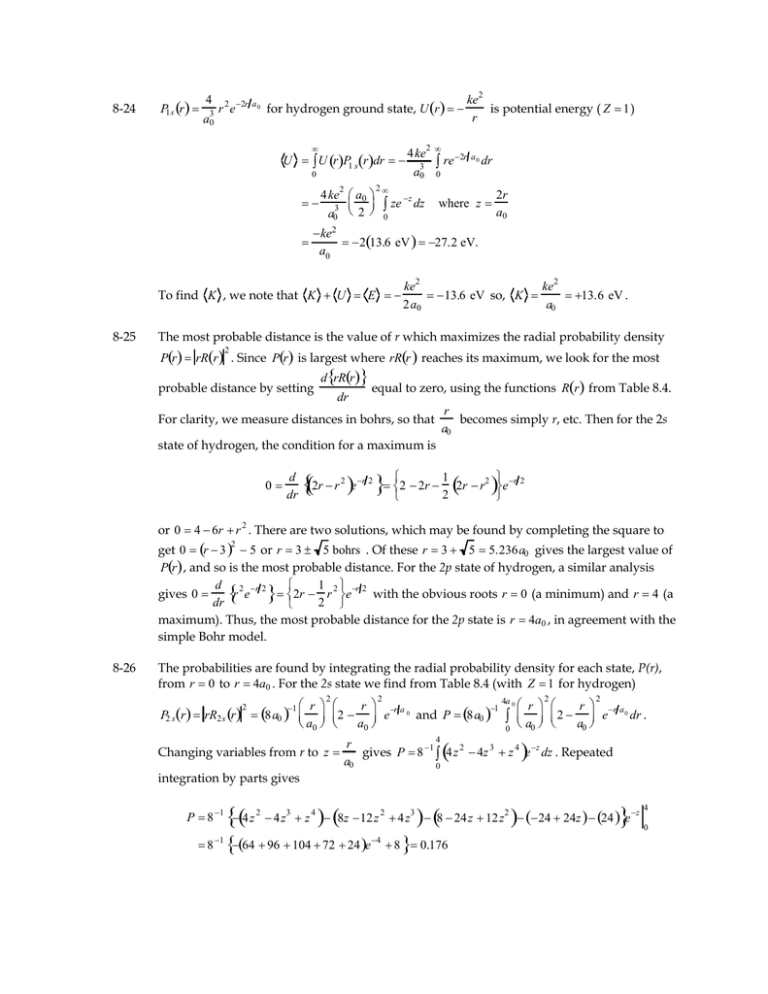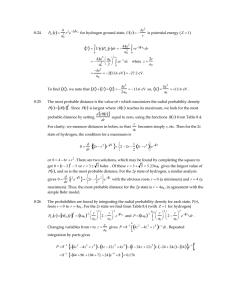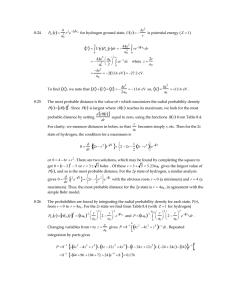Document 10944280
advertisement

8-24 P1s r 4 2 2r r e a30 a0 for hydrogen ground state, U r U U rP1 srdr 0 4ke a0 a03 2 re 2r a 0 dr 0 2r z ze dz where z a 0 0 ke 213.6 eV 27.2 eV. a0 2 To find K , we note that K U E 8-25 2 2 2 4ke 3 a0 ke2 is potential energy ( Z 1 ) r ke2 ke2 13.6 eV so, K 13.6 eV . 2 a0 a0 The most probable distance is the value of r which maximizes the radial probability density Pr rRr . Since Pr is largest where rRr reaches its maximum, we look for the most 2 probable distance by setting drRr dr equal to zero, using the functions Rr from Table 8.4. For clarity, we measure distances in bohrs, so that r becomes simply r, etc. Then for the 2s a0 state of hydrogen, the condition for a maximum is 0 2r r e 2 2r 12 2r r e d dr 2 r 2 2 r 2 or 0 4 6r r 2 . There are two solutions, which may be found by completing the square to get 0 r 3 5 or r 3 5 bohrs . Of these r 3 5 5.236a0 gives the largest value of Pr , and so is the most probable distance. For the 2p state of hydrogen, a similar analysis 1 2 r 2 d 2 r 2 r e 2r r e with the obvious roots r 0 (a minimum) and r 4 (a gives 0 2 dr maximum). Thus, the most probable distance for the 2p state is r 4a0 , in agreement with the simple Bohr model. 2 8-26 The probabilities are found by integrating the radial probability density for each state, P(r), from r 0 to r 4a0 . For the 2s state we find from Table 8.4 (with Z 1 for hydrogen) 2 Changing variables from r to z integration by parts gives 2 2 2 4a 0 r r r r a r r a 1 2 e 0 and P 8a0 2 e 0 dr . a0 a0 a0 0 a0 1 P2 sr rR2 s r 8a0 2 4 r gives P 8 1 4z 2 4z 3 z 4 e z dz . Repeated a0 0 P 8 1 4 z 2 4 z3 z 4 8z 12 z 2 4 z3 8 24 z 12z2 24 24z 24 e z 8 1 64 96 104 72 24 e 4 8 0.176 4 0 For the 2p state of hydrogen P2 p r rR2p r 24 a0 P 24a0 1 4a 0 4 r 4 1 2 r r a e 0 and a0 4 r a 1 4 z e 0 dr 24 z e dz . Again integrating by parts, we get a 0 0 0 4 P 24 1 z 4 4z 3 12z 2 24z 24 e z 0 24 1 824e 4 24 0.371 . The probability for the 2s electron is much smaller, suggesting that this electron spends more of its time in the outer regions of the atom. This is in accord with classical physics, where the electron in a lower angular momentum state is described by orbits more elliptic in shape. 8-29 To find r we first compute r2 hydrogen: P1 s r r2 4 a30 2 2r a 0 r e . Then r2 r 2 P1 s rdr 0 r 4 2r 4 2 r a r e 0 dr . With z a , this is a30 0 0 5 4 a0 4 z 4 z z e dz . The integral on the right is (see Example 8.9) z e dz 4 ! so that 3 2 a0 0 0 5 2 using the radial probability density for the 1s state of 4 a0 2 2 3 4! 3 a0 and r r r 2 a0 3 a 2 12 2 0 1.5 a0 2 12 0.866a0 . Since r is an appreciable fraction of the average distance, the whereabouts of the electron are largely unknown in this case. 8-30 The averages r and r2 are found by weighting the probability density for this state Z 2 2 Zr P1 s r 4 3 r e a0 a0 with r and r , respectively, in the integral from r 0 to r : 2 Z 3 2 Zr r rP1 s rdr 4 3 r e a0 0 0 a0 dr Z r2 r 2 P1 s rdr 4 3 r 4 e 2 rZ a0 0 0 Substituting z a0 dr 2 Zr gives a0 3 Z a0 4 3 z 3! a 3 a r 4 z e dz 0 0 a 4 Z 2 Z 2 Z 0 0 3 Z a r2 4 0 a0 2 Z 5 12 a0 9 3 Z 4 from the average potential energy and r r 2 r U kZe 2 0 2 12 4 z z e dz 0 2 2 4! a0 a0 3 8 Z Z a0 0.866 . The momentum uncertainty is deduced Z 3 Z 1 P1 srdr 4kZe 2 re 2 Zr a0 0 r Z a k Ze 4kZe 2 0 . a0 2Z a0 3 a0 2 2 k Ze 2 for the 1s level, and a0 , we obtain Then, since E 2a0 m e ke2 2 2m e k Ze Z 2me K 2me E U . a0 2a0 2 2 p 2 With p 0 from symmetry, we get p p consistent with the uncertainty principle. E 2BB hf 2 9-1 12 Z and rp 0.866 for any Z, a0 2 9.27 10 24 J T 0.35 T 6.63 10 34 Js f so f 9.79 10 9 Hz 9-4 (a) 3d subshell l 2 m l 2, 1, 0, 1, 2 and m s l ml ms 2 2 2 2 2 2 2 2 2 2 –2 –2 –1 –1 0 0 1 1 2 2 –1/2 +1/2 –1/2 +1/2 –1/2 +1/2 –1/2 +1/2 –1/2 +1/2 1 for each m l 2 n 3 3 3 3 3 3 3 3 3 3 (b) 3p subshell: for a p state, l 1 . Thus m l can take on values l to l, or –1, 0, 1. For each 1 m l , m s can be . 2 l ml ms 1 1 1 1 1 1 –1 –1 0 0 1 1 –1/2 +1/2 –1/2 +1/2 –1/2 +1/2 n 3 3 3 3 3 3 9-6 The exiting beams differ in the spin orientation of the outermost atomic electron. The energy difference derives from the magnetic energy of this spin in the applied field B: e U s B g S zB gB Bm s . 2m 1 With g 2 for electrons, the energy difference between the up spin m s and down spin 2 1 m orientations is s 2 2 2 2 From Equation 8.9 we have E 2 n1 n 2 n 3 2mL U gBB 2 9.273 10 24 J T 0.5 T 9.273 10 24 J 5.80 10 5 eV . 2 9-17 2 1.054 10 34 2 n12 n22 n32 1.5 10 18 J n 2 n 2 n 2 9.4 eV n 2 n 2 n 2 E 1 2 3 1 2 3 2 2 9.11 10 31 2 10 10 2 (a) 2 electrons per state. The lowest states have n12 n22 n32 1, 1, 1 E111 9.4 eV12 12 12 eV 28.2 eV . For n12 n22 n32 1, 1, 2 or 1, 2, 1 or (2, 1, 1), 2 E112 E121 E211 9.4 eV 1 1 2 2 2 56.4 eV E min 2 E111 E112 E121 E211 2 28.2 3 56.4 398.4 eV (b) All 8 particles go into the n12 n22 n32 1, 1, 1 state, so E min 8 E111 225.6 eV . 9-21 2 2 4 (a) 1s 2s 2p (b) For the two 1s electrons, n 1 , l 0 , ml 0 , ms For the two 2s electrons, n 2 , l 0 , m l 0 , m s 1 . 2 1 . 2 For the four 2p electrons, n 2 , l 1 , m l 1, 0 , 1 , m s 1 . 2 ! 9-15 The spin of the atomic electron has a magnetic energy in the field of the orbital moment $ e ' given by Equations 9.6 and 9.12 with a g-factor of 2, or U = "µ s # B = 2 & S B = 2µBmsB . % 2me )( z The magnetic field B originates with the orbiting electron. To estimate B, we adopt the equivalent viewpoint of the atomic nucleus (proton) circling the electron, and borrow a result from classical electromagnetism for the B field at the center of a circular current 2k µ 2 loop with radius r: B = m3 . Here km is the magnetic constant and µ = i" r is the r magnetic moment of the loop, assuming it carries a current i. In the atomic case, we identify r with the orbit radius and the current i with the proton charge +e divided by the 2" r evr " e % orbital period T = . Then µ = = L where L = me vr is the orbital angular 2 $# 2me '& v 1 2 momentum of the electron. For a p electron l = 1 and L = [ l(l + 1) ] h = 2h , so " eh % µ =$ 2 = µB 2 = 1.31 ( 10 )23 J T . For r we take a typical atomic dimension, say # 2me '& ( ) 4 a0 = 2.12 " 10 #10 m for a 2p electron, and find B= Since ms is ± ( )( ) = 0.276 T . 2 10 "7 N A 2 1.31 # 10 "23 J T 3 (2.12 # 10 "10 m ) 1 the magnetic energy of the electron spin in this field is 2 ( ) U = ± µB B = ± 9.27 " 10 #24 J T (0.276 T ) = ±2.56 " 10 #24 J = ±1.59 " 10 #5 eV . The up spin orientation (+) has the higher energy; the predicted energy difference between the up (+) and down (–) spin orientations is twice this figure, or about ! 3.18 " 10 #5 eV —a result which compares favorably with the measured value, 5 " 10 #5 eV . ! ! ! 9-24 Ato m 3s 3p 4s Electr on Co nfig urat ion Na [Ne]3s1 Mg [Ne]3s2 Al [Ne]3s23p1 Si [Ne]3s 3p P [Ne]3s23p3 S [Ne]3s23p4 Cl [Ne]3s23p5 Ar [Ne]3s23p6 K [Ar]4s1 2 2 The 3s subshell is energetically lower and so fills before the 3p. According to Hund’s rule, electrons prefer to align their spins so long as the exclusion principle can be satisfied.




